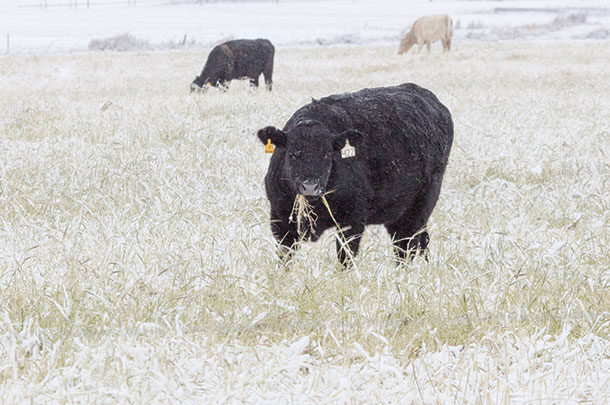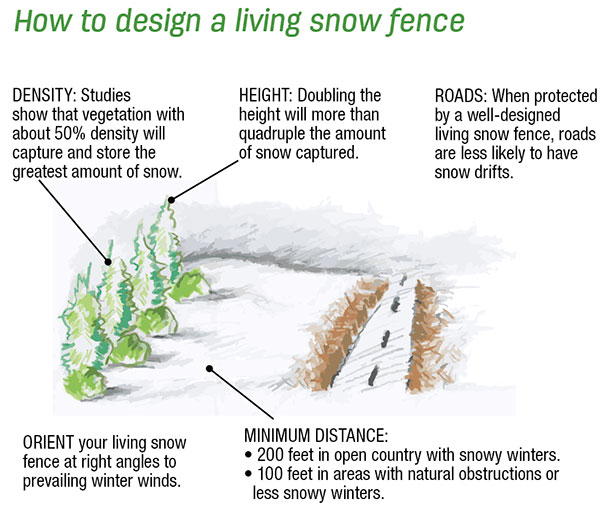Deliberate detail
Because features of individual geographic locations will greatly impact the function of each snow fence, knowing how to evaluate the location in terms of tree location, wind direction and velocity, and species appropriate to the area are all key factors in satisfactory snow fence design.
Most windbreaks are designed to spread snow across a large area or dump it in a relatively small area. Windbreaks in fields are typically tall and relatively porous. Snow captured in the windbreak can provide important moisture for trees and shrubs when it begins to melt.
Martin Curry, rangeland specialist at Laramie Rivers Conservation District in Wyoming, says planting trees too close together and underestimating mature tree size are common issues seen in living snow fence design.
“It’s critical to project where a snow fence will cause wind-blown snow to fall,” Curry says. “You don’t want to direct it too close to either structures or roads. When you plant small trees, it’s challenging to envision what the mature tree will look like or how much space it will need.
But most trees reach 10 times their height by the time they mature. Typically, trees should be planted at a minimum of 100 feet from any structure.”
Windbreak and snow fence design should also take into consideration any nearby traffic areas, including corners and intersections, where visibility may be hindered by the matured windbreak.
Location, location, location
Curry notes that knowledge of regional soil types and tree growth patterns are also crucial to successful snow fence design. Trees that grow quickly and up to 30 feet in one area, may grow much more slowly and only reach half that height in another location.
Elizabeth Killinger, Nebraska extension educator in Hall County, notes that tree species appropriate to the west side of the state won’t necessarily fare well in the east.
“We recommend that landowners work with their local Natural Resources District (NRD) to design the snow fence or windbreak and determine tree species and how many trees they need,” she says. “NRD will also help plant the trees.
A windbreak or snow fence has to be planted far enough away from a road to ensure that blowing snow falls in the ditch, not on the road or in the middle of the farm yard. The taller the mature trees in the fence, the further out the snow will be dumped.”
The Natural Resources Conservation District Web Soil Survey provides exact details about soil types and quality for specific sites, providing details about tree and shrub species growing in specific regions.
“By planting trees appropriate to the area, the snow fence will live longer and be a better economic investment,” Curry says.
Take a look around
Identifying existing elements near the snow fence site is also important in order to avoid planting over septic tanks or power lines in a farm yard or irrigation equipment or sources in a field.
“The first thing I do when I’m called to visit a potential snow fence site is to locate those types of elements,” Curry says. “I also ask the landowner why they want to plant the trees. What are they trying to accomplish?”
Click here or on the image above to view it at full siae in a new window.
Drawing a rough sketch of the proposed snow fence or windbreak can help visualize the project. The most common snow fence design includes three rows: One shrub row to absorb the first brunt of wind, a medium evergreen row in the middle and a larger evergreen row closest to the protected area. The more rows planted, the more dense the snow fence will be.
Distinct preparation
“When we plant, we rip the site down to 3 feet to break up soil compaction,” Curry says. “We rototill the top 6 inches and then install a fabric weed barrier to discourage competition. Depending on the site and the landowner’s requirements, we will also install a drip irrigation system.”
The weed barrier also helps retain moisture and reduce the amount of work required to support establishment of the trees in the first two to three years. Even digging holes for the trees is important as roots that curve up toward the soil surface can result in tree death and large air pockets in the hole can cause roots to dry out.
Watering new trees is necessary; however, overwatering should be avoided. Drip irrigation is most effective. A watering strategy could be included in the snow fence design.
Natural adversaries
Soil amendments intended to improve water retention, water infiltration, drainage, aeration or soil structure could be included in a snow fence design. However, over time, tree roots will grow beyond the improvements.
Selecting trees appropriate to the region is the best option. High-nitrate fertilizers could burn tree roots and are not recommended within the first three years of planting.
“Most of the trees in our area don’t like chemical weed control,” Curry says. “We advise pulling weeds by hand. If a drip system is installed, that may also require some maintenance until trees are established. If any of the trees die out those first couple of years, they need to be replaced.”
Depending on landowners’ goals for the snow fence, wildlife may find shelter in the snow fence; however, a new planting may also need protection from wildlife for a few years.
“Deer and rabbits can do a lot of damage to young trees, even killing them,” Curry says. “They need to be monitored and babied the first few years.”
Drought protection
Windbreaks in Nebraska are often used to help stop snow on cropland, giving landowners an advantage in capturing precious moisture.
“In drought situations, a windbreak can be well worth the investment because it puts as much moisture as possible on the field,” Killinger says. “If the windbreak is designed properly, snow can be dumped in a pretty specific area. An added benefit of windbreaks on cropland is the shelter they provide to livestock. If an existing windbreak has deteriorated, it may be fairly simple and valuable to complete a renovation.”
Whether it’s shrubs or evergreens that die out in a windbreak, their loss greatly diminishes the windbreak’s effectiveness. If significant segments of the windbreak need to be replaced, it can be done in sections if necessary.
“Sometimes so many lower limbs of windbreak trees have become bare that it’s no longer effectively stopping wind,” Killinger says. “We’ve also seen some pine wilt and other evergreen diseases in Nebraska.
It’s possible that taller shrubs could be used to fill in the gaps left by trees limbing themselves up. If entire rows need renovation, it may be possible to replace one row at a time to avoid complete renovation all at once.” ![]()
PHOTO: “In drought situations, a windbreak can be well worth the investment because it puts as much moisture as possible on the field.” Photo by Mike Dixon.
ILLUSTRATIONS: How to design a living snow fence. Illustrations by Corey Lewis.

-
Loretta Sorensen
- Freelance Writer
- Yankton, South Dakota












